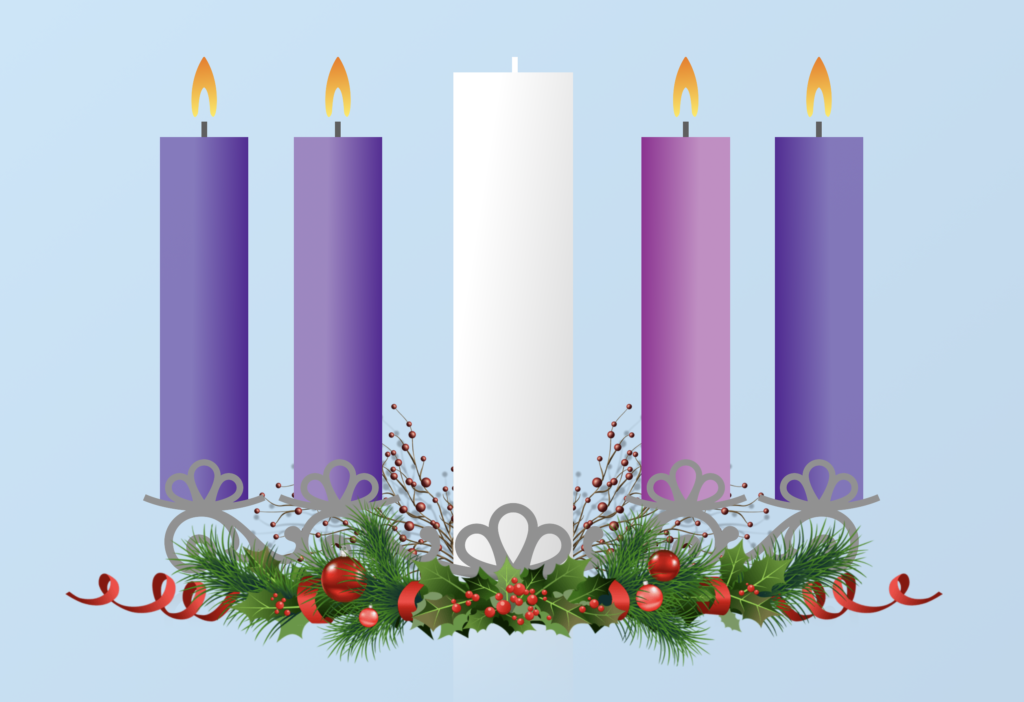
This devotional comes from Mennonite Church USA’s (MC USA) 2020 Advent at Home devotional, “We Wait for Jesus,” which focuses on the Advent themes of hope, peace, joy and love. It was written by Talashia Keim Yoder, pastor of Christian Formation at College Mennonite Church in Goshen, Indiana.
This Week’s Story: Simeon and Anna
Daily Ritual
- Light three purple candles and the pink candle, saying something like, “Jesus will bring hope, peace, joy and love.” Light the middle candle and say, “Jesus is born!”
- Weekly scripture reading: Luke 2:21-38.
- Daily scripture readings: Jeremiah 31:7-14; Psalm 147:12-20, Ephesians 1:3-14; John 1: 1-9, 10-18.
- Pray: God, thank you for the wise people, like Simeon and Anna, that surround parents. Thank you for your guiding Holy Spirit.
Help us to recognize you breaking into our world. Amen.
- Sing a song of Jesus’ birth.
Weekly Worship Ritual
Tell the story
Luke 2:21-38
If you have Shine On: A Story Bible, this story is found on pages 169.

Put it in context
Jesus was born in humble circumstances, visited by shepherds and proclaimed by angels. When he was eight days old, he was brought to the temple to be circumcised and presented. A devout man named Simeon and a prophet named Anna recognized him as the Messiah.
Talk about it
Choose the prompts that are appropriate for your household.
- This presentation at the temple may refer to a dedication of sorts. What infant dedications have you participated in? Were you dedicated as an infant? Why did your parents make that choice? What did it mean?
- In Simeon’s speech in verses 29-32, he references familiar passages from Isaiah (Isaiah 52:10, Isaiah 49:6 and Isaiah 46:13). Then in verses 34-35, he foreshadows what will come. What do Simeon’s words tell you about Jesus?
- In verse 36, Anna is rather off-handedly called a “prophet.” How does this strike you? What else do we know about her?
- Simeon had been promised he would see the Messiah, and after he did, he said he was ready to die. Imagine this and talk about it.
- Verse 33 says Mary and Joseph are “amazed at what was being said about Jesus.”
Why might they feel as they do? - Simeon and Anna are both described as old, wise and devout. They fill in a necessary piece of the story of Jesus’ birth. Look back over the diversity and depth of the characters in this New Testament story so far.
Tell it your way
Add to your “Journey to Bethlehem” mural.
Epiphany Day: January 6, 2021
The Visit of the Magi
Epiphany means realization. Here’s the dictionary.com definition: “a sudden, intuitive perception of or insight into the reality or essential meaning of something, usually initiated by some simple, homely, or commonplace occurrence or experience.” It’s when you suddenly get something. It’s finally clear, it makes sense. We often associate Epiphany with a shining light that illuminates Jesus. Jesus is the realization of all that has been hoped for and promised.
Epiphany Day Ritual
- When it is dark outside, gather up all the candles and flashlights you can find and bring them into one room of your house. Turn off all the lights in the house.
- Light the candles and flashlights one at a time, beginning with the advent wreath. Say your advent words with the wreath, “Jesus will bring hope, peace, joy and love. Jesus is born!” Then, just keep noticing the difference all these little lights make.
- By the light of your candles and flashlights, read and explore the story.
- Scripture reading: Matthew 2:1-12.
- Pray: God, we are so glad you sent Jesus to be our light! The Magi were overjoyed when they found Jesus. Thank you for the people from far away who can see your light. Thank you that Jesus is for everyone. Amen.
- Sing a song of Jesus as the light.
- Blow out the candles.
Tell the story
Matthew 2:1-12
If you have Shine On: A Story Bible, see page 170.

Put it in context
Jesus was born in humble circumstances, visited by shepherds and proclaimed by angels. Then, when he was about a year old, Magi, or Wise Men, came to worship him and give him gifts. These visitors were from far away, and were from outside the Jewish faith. Jesus was born for everyone.
Talk about it
Choose the prompts that are appropriate for your household.
- Notice the uses of the title “King” in the first couple of verses. What do you think the writer of Matthew might be trying to point our attention to?
- Notice how God speaks to the Magi in this story. Look back at Matthew 1:20 and forward to Matthew 2:13. What’s going on here?
- What in the world were these Magi/Wise Men/Kings? Magi were a class of Zoroastrian priests, known as great astrologers. They probably came from Persia. Interestingly, early Jewish readers of this story would have regarded Persian astrologers as foolish, not wise.
- What do these gifts mean? Gold has much the same meaning and value today, but frankincense and myrrh take a little more explanation. They were often used for religious rituals, including the anointing of kings and burial. These gifts may have had different symbolic meanings at different points in Jesus’ life. Do you think Mary, Joseph and Jesus ever used these gifts?
- The Magi are not descendants of Abraham and Sarah, but Gentiles. Think back to Jesus’ genealogy. Here we have one more foreshadowing of the mission to the Gentiles. The definition of the people of God was expanding. If you think of this expansion as a continuing pattern throughout history, what does that mean for us today?
- What do you make of the lurking danger in this story? What is Herod up to, enlisting the explanations of the scribes and priests and asking to pay homage?
Tell it your way
Add to your “Journey to Bethlehem” mural.

Visit MC USA’s Faith Formation page to find a one-stop hub of formation resources for all ages, curated through an Anabaptist lens.

